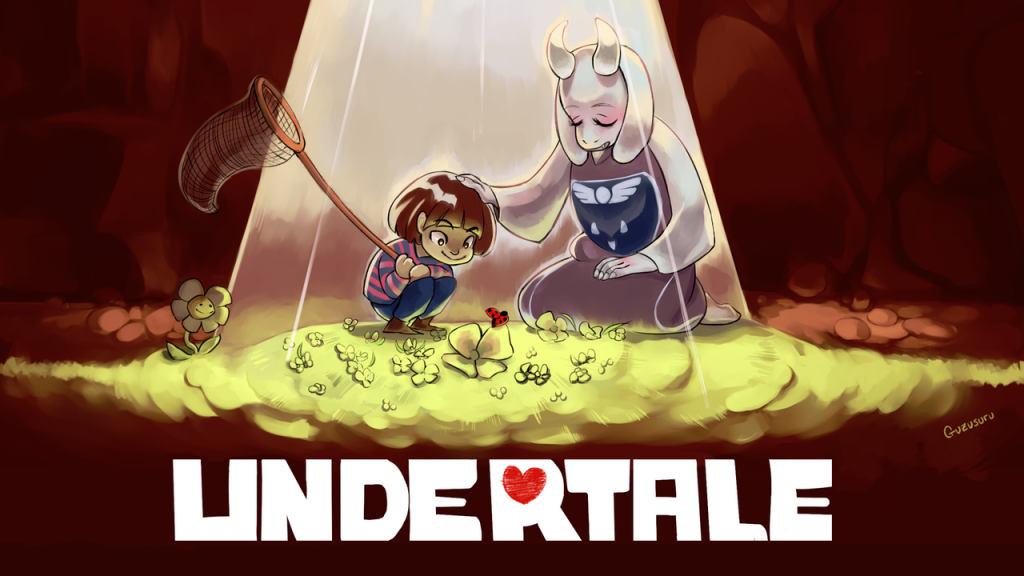Were you on Tumblr in the period around 2015-2017? Have you been reading on Twitter in the past week or two? Are you even a little bit interested in the indie game market? If your answer to any of the previous questions was “yes”, there’s a good chance you’ve heard at least once of the game Undertale. This game has made a significant impact on people’s cognition, even earning the coveted attention of big companies like Nintendo. But what did these games do to deserve so much praise and attention? Allow me to take you on a journey to the Underground, the realm of monsters… (spoilers for Undertale ahead, you have been warned!)
The Start of the (Under)Tale
On September 15th 2015, a game developer known online as Toby Fox released a game on Steam called Undertale. The game was an RPG with simple 8-bit graphics, a charming cast of characters, funny and tongue-in-cheek dialogue, lovingly crafted music and story, and a healthy dose of mystery and intrigue. What made the game so interesting and unique though, is how it approaches battles. As in any RPG, you occasionally come across monsters that will fight you. However, unlike in most RPGs, in Undertale you have the option to spare enemies rather than kill them. In fact, if you so choose, you don’t even have to fight at all, you can simply talk to the enemies, help them with their issues in battle, and convince them to stop fighting you. This is where Undertale players will choose which route they will take through the game, out of the following three: Pacifist, Neutral, or Genocide. I will briefly delve into the Pacifist and Genocide routes, as these are the most interesting to talk about.

The Pacifist Route
This Pacifist route is the most popular route to take through the game. This is the route you end up taking if you listen to one of the first major characters Toriel’s advice and spare every enemy you come across. This route will let you experience most of the story, let you bond with the main cast of characters and end up becoming their friend, and eventually learn the truth of why you’re in the Underground, the place where the game takes place. You’ll naturally grow to fall in love with the charming characters, and on the way, the game tells a story of loss, identity, and growth. In the end, you fight the antagonist Flowey, and suddenly the True Pacifist route opens up where you can meet Asriel, the dead child of the King of Monsters and Toriel. After a difficult battle and a tearful goodbye, the credits roll, and you’re left with a bitter-sweet music box melody as you stare at the end screen. I’ll admit, I cried when I reached this part. A lot.
This route makes you remember your humanity and has you use empathy to solve your problems, rather than violence.
The Genocide Route
The total antithesis of the Pacifist route, the Genocide route has you instead playing a more “traditional” RPG. Monsters are monsters and therefore must be slain, right? If that’s what you believe, the Genocide route’s story and message are directed squarely at you. At the start of the game, everything seems normal. Until you realise that to actually do the Genocide route, you need to hunt and kill every last monster in every area, deliberately. Simply slaying those that you come across is not enough, it will simply trigger the Neutral route. The game quickly turns a dark corner here. Enemies start to run away for you, beg you for mercy, all fun and cheeky dialogue gets replaced with serious, even ominous dialogue, or sometimes just completely removed. The music becomes more and more sinister. This continues this way in each area until you see this in an encounter…

The game goes silent. You’ve done it. You’ve cold-heartedly slain every monster in the area. Go on and carve your path of destruction to the next area. And this slaying does not simply stop at the random monsters you find throughout the Underground. All those charming characters you grew to befriend and love in the Pacifist run, you have to kill them all by your own hands. Eventually, you reach the end, where the usually jokey and funny character Sans meets you and blocks your path to make you pay for the sins you have committed. His fight is insanely difficult, a punishment for the blood on your hands, and Sans makes this clear, as he is aware of every time you restart, and his dialogue changes every attempt accordingly. Until, if you are Determined enough, he falls to your blade as well. In the end, you’re taken over by the malevolent spirit known as Chara, and you die yourself.
A Final Reflection
Where the Pacifist run brings you a heartrending and charming story of friends, dealing with loss, and growing up, the Genocide run is a commentary on those RPG players who go out of their way to kill every monster they can find for that all-important EXP (in Undertale aptly named “Execution Points”). It makes you feel disgusted at yourself for what you have to do to get stronger. It’s a grim “what if” story about the implications of players killing monsters in a game, and it really makes you reflect on your morality by the end of it.
Undertale is a very clever game. It can truly toy with a player and make them think about their actions or behaviour. Toby Fox made something truly special all those years ago, and the fact the game still gets talked about to this day goes to show that.
P.S. I do not consider myself emotionally strong enough to ever do the Genocide route, I will never kill my innocent Papyrus


Recent Comments